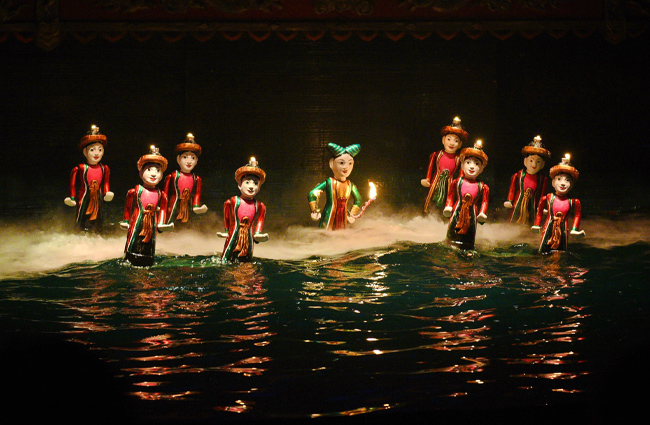So what should I try?
I always recommend trying the local dishes specific to wherever you are at the time, even though Vietnam is a relatively small country it is still diverse and has three distinctly different culinary zones; Northern, Central and Southern.
Northern Vietnam


Northern Vietnamese cooking is the least bold in flavor compared to the rest of Vietnam, a colder climate means less spices are able to grow. Northern foods feature light and balanced flavors with a little black pepper is used to give it some spice. In the past pork, beef, and chicken in dishes were rare, most dishes centred on freshwater fish, prawns, squids, shrimps and crabs, flavoured with fish sauce, soy sauce, prawn sauce, and limes.


Northern Vietnamese cuisine has a strong Chinese influence, so while rice is a staple in the rest of Vietnam, the North has a preference for noodles,
Typical dishes include;
Pho – broth, noodles (made from rice), a few herbs, and meat – normally beef, often with a side of bean sprouts and coriander or spear mint for you to add as you wish.
Bun rieu – crushed crab and tomatoe soup with hearty chunks of tofu, pig’s blood sausage and served with a side of beans sprouts and spearmint for you to add.
Banh cuon – rice noodle roll filled with seasoned ground pork, mushroom, and shallots served with sliced cucumber, bean sprouts, and a Nuoc cham dipping sauce (fish sauce, sugar & lime).
Banh Bao – steamed bun dumpling stuffed with onion, mushrooms, vegetables, egg or meat. Great for a snack or for eating on the go, you will find them steaming hot all day at most markets, bus stops or vendors with a trolley of them outside tourist attractions.
Central Vietnam


Central Vietnam is known for its spicy food, due to the abundance of spices produced by its mountainous terrain. They face harsh weather conditions throughout the year, so don’t have as many green ingredients as the rest of Vietnam, but the coastline around the central Vietnam area is known for its salt and fish sauce industries, two ingredients you will find in their daily diet along with plenty of chilli peppers.
Hue was the capital of the last dynasty of Vietnam, so their cuisine often reflects the influence of ancient Vietnamese royalty. Sophisticated meals with lots of complex, very decorative dishes, served in small portions.
Typical dishes include;
Bun Bo Hue – a popular Vietnamese soup containing rice noodle (bun) and beef (bo) – sometimes oxtail or pig knuckle – served with green onion, bean sprouts, banana flower, raw onion, mint, basil and lime.
Banh xeo – ‘sizzling cake’, savoury fried pancakes made of rice flour, stuffed with slivers of fatty pork, shrimp, diced green onion, and bean sprouts. Served wrapped in mustard leaf or lettuce leaves and dipped in a sweet and sour diluted fish sauce.
Southern Vietnam


The warm weather and fertile soil of southern Vietnam – especially the Mekong Delta – are ideal growing conditions for not just rice but a huge variety of different fruits, vegetables and livestock and seafood is a natural staple for the people of the south.


The South Vietnamese prefer sweeter foods and use a lot of coconut milk in their cooking.

Typical dishes include;
Ca Kho To – Caramelized catfish in a clay pot, served with (Com Trang) plain white rice.
Canh Chua Ca Loc – Sour soup made with snakehead fish, pineapples, tomatoes, herbs, bean sprouts, tamarind, and various vegetables, served with (Nuoc Mam) Fish Sauce.
Cha goi – Spring rolls: deep-fried flour rolls filled with pork, yam, crab, shrimp, rice vermicelli, mushrooms and other ingredients
Goi cuon – Salad rolls: rice paper rolls that are dipped into water to soften and often include shrimp, herbs, pork, rice vermicelli and other ingredients wrapped up then dipped in nuoc cham or peanut sauce.
Che – A sweet dessert made from beans and sticky rice. There are many different varieties to try all throughout Vietnam, each with different fruits, beans and other ingredients. They can be served hot or cold and often with coconut milk.
Drinks – Enjoyed throughout Vietnam



Jasmin tea – Initially Jasmin tea came from Persia via China but now it is grown in Vietnam. The local way of welcoming a guest into a Vietnamese home is to share a small cup of hot Jasmin tea, in the south it is often served with fresh seasonal fruits. Tea is for every occasion and almost any ware there is a group of people you will find small street-side stall selling tea. Watch how the locals drink there hot drinks, not straight from the cup but often poured into the saucer to cool it first.
Ca phe su da – Strong iced coffee, served with sweetened condensed milk at the bottom of the cup to be stirred in. Now days you will find ‘iced coffee’ in almost every small street side tea shop, it’s a very refreshing drink on a hot day and cost a fraction of a starbucks.
Bai hio – ‘Fresh Beer’, you will normally find it in small bars and on street corners. The beer is brewed daily and each bar gets a fresh batch delivered every day. It is a very light lager, aprox 3% and cost a fraction of the price of any western beer.
If you are in Hanoi then the best place to try it is on Bia Hoi Corner in the heart of the Old Quarter, sitting on the small plastic seats chatting to locals and tourist alike watching the city come to life.
To try some of the dishes mentioned above, why not enjoy one of Tucan Travel’s Vietnam Tours.
About the Author: Owen is Sales & Marketing Executive for Tucan Travel. He has travelled and tour led extensively on Group Tours and independently to South and Central America, Asia, Australia, Western Europe and Africa. You can find him on Google+ or read his other contributions here.
Spread the love
We travelled to Vietnam with G Adventures.



